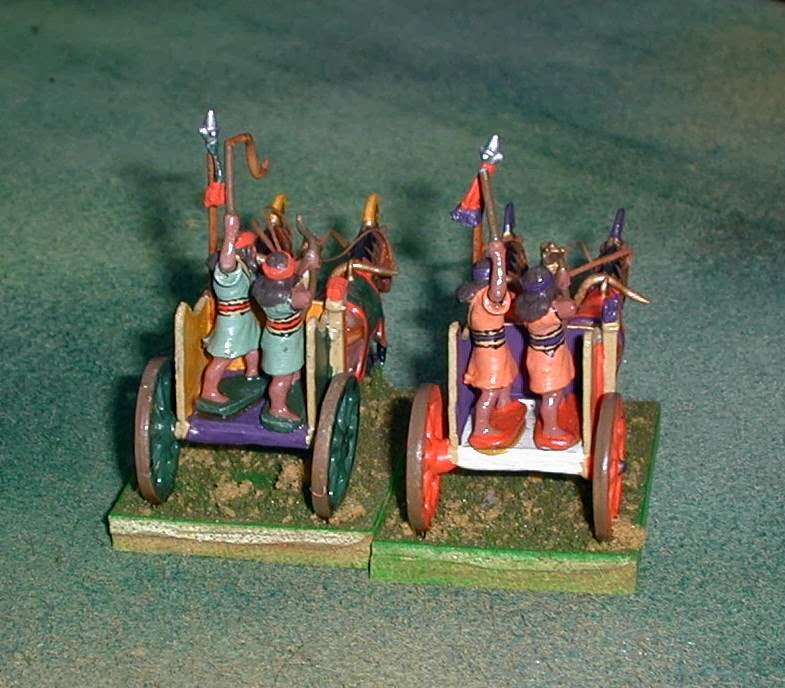nor all your piety nor wit,
Total: 372 infantry, 20 cavalry, 40 crew, 12 guns, 9 chariots, 8 space ships, 1 Terrain piece; overall a pretty successful year, focused on the Napoleonic Prussians, NK Egyptians, and the start of my 1815 project.
Shall lure it back to cancel half a line,
Nor all your tears blot out a word of it.
(from The Rubaiyat of Omar Khayyam)

A Water Clock from Ptolemaic Egypt
It is the time of year for all good wargaming bloggers to look back upon the past year's successes and failures, and look ahead to our plans for the coming year. Who am I to buck the trend? :-)
2013 in Review
1) Painting
Young Guard Voltigeurs and Tirailleurs - 74 figures
Prussian Reserve Regiments (grey uniforms) - 60 figures
Prussian Reserve Infantry in British" style unuiforms - 30 figures
Prussian Reserve Infantry in Litewka - 30 figures
Prussian Landwehr cavalry and mounted officers - 20 figures
Prussian Artillery - 40 crew figures and 12 guns
Prussian Guard Infantry - 16 figures
Entomalian Space Ships for Galactic Knights - 8
New Kingdom Egyptians: 60 Melee infantry, 30 Archers, 9 chariots
British Line/Light Infantry - 72 figures
1 Peninsular Windmill
British Line/Light Infantry - 72 figures
1 Peninsular Windmill
Total: 372 infantry, 20 cavalry, 40 crew, 12 guns, 9 chariots, 8 space ships, 1 Terrain piece; overall a pretty successful year, focused on the Napoleonic Prussians, NK Egyptians, and the start of my 1815 project.
2) Gaming
Battle on the Piave, 1809 - Field of Battle, 2nd edition -with Barry
1813 Campaign in Day with Snappy Nappy - with the Hartford Area Historical Gaming Society
Ancients Battle at HAVOC convention using Charlie Sweet's rules
Battle of Mockern, 1813 - at Historicon using FoB2
Battle of Dresden, 1813 - at Historicon using FoB2
Battle of Novarra, 1513 - at Historicon using my own Band of Brothers
2 Star Navy gaming sessions - with Barry, using Star Navy 5150
Just 8 games; not a great performance there! My favorites were the 1813 Campaign in a Day and Novarra.
2 Star Navy gaming sessions - with Barry, using Star Navy 5150
Just 8 games; not a great performance there! My favorites were the 1813 Campaign in a Day and Novarra.
3) Blogging
89 posts (up from 81 last year), 171 followers, over 82,00 page views this year. I am particularly proud of my lengthy series on the Danish Army of the Napoleonic Wars.
4) Publications
My "Blunders on the Danube 1809" Scenario Book for FoB is now available as a pdf as well as the existing hard copy version: for $15, payable to Brent Oman via PayPal at brentoman@q.com .
Goals - Looking forward to 2014
1) Painting
I have about 250 more British Napoleonic infantry, 40 Artillery crew and 12 guns, and about 50 British cavalry to do for my 1815 project; I may need some more Prussians and some Anglo Al;lied troops as well once I tally up everything that thje scenarios will require, and what others have available. will need. This doesn't have to be completed until July, 2015, however.
I have another 60 Egyptian Infantry and 7 more Chariots to paint - the urgency of that will depend upon what games I plan to run, and when/where!
I have 16 Austrian Hussars and an Austrian Cavalry battery that I don't need for any project, but I just *want* to paint up. Then there are the Tyrolean rebels...
Paint up the rest of my Entomalian Sapce ships.
I still have quite a few Landsknechts, Gendarmes, and other Renaissance/Late Medieval era cavalry that I can add to my existing forces if I feel motivated - once again, what and whether I do any of them next year that will probably be driven by what games I plan,.
I still have quite a few Landsknechts, Gendarmes, and other Renaissance/Late Medieval era cavalry that I can add to my existing forces if I feel motivated - once again, what and whether I do any of them next year that will probably be driven by what games I plan,.
2) Gaming
Try to do more! 12 games a year is a reasonable goal. We'll see! :-)
I need to settle on and plan a game for Havoc soon, but have no idea really what I want to do there!
I will probably do three games for Historicon - one will be Montmirail 1814, possibly another 1814 battle or an 1813, possibly one using Pulse of Battle Ancients rules, possibly a Renaissance galley warfare game (15mm ships).
I also need to plan one for Ellis Con in the Fall, too.
Get in at least a game of two with the HAHGS guys, and drag Barry, etc to the wargames table more often!
I will probably do three games for Historicon - one will be Montmirail 1814, possibly another 1814 battle or an 1813, possibly one using Pulse of Battle Ancients rules, possibly a Renaissance galley warfare game (15mm ships).
I also need to plan one for Ellis Con in the Fall, too.
Get in at least a game of two with the HAHGS guys, and drag Barry, etc to the wargames table more often!
3) Blogging
No major goals there - just continue posting regularly. I don't think I can do much more than I have done this year without it diverting time from other aspects of my hobby and non hobby life! I am considering using the "Napoleonic Troops" page to index all the uniform/flag information that I have posted., or maybe using an entirely new page for that.


















































